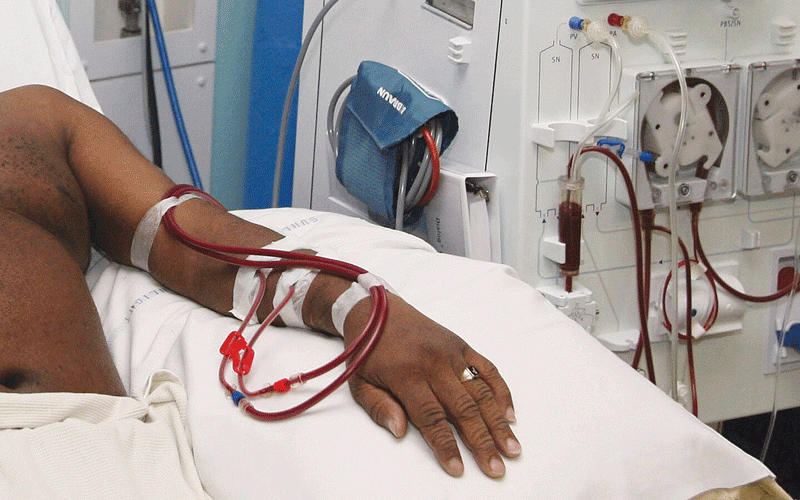
THE news of her suffering from Stage 2 cervical cancer caught Rutendo Mhonda (not real name) unawares.
Unsure of what to do next, the fear of having cancer took a toll on her.
Mhonda had no knowledge what it meant to be diagnosed with cancer. In fact, she thought that was the end of her life.
To worsen the situation, the diagnosis came in 2020 when the nation was grappling with the deadly COVID-19 pandemic.
The medical facilities across the country were overwhelmed and failing to contain the influx of COVID-19 patients, relatives say.
The fact that more attention was being given to the global pandemic had a negative impact on other deadly diseases, including cervical cancer.
For Mhonda, travelling to Parirenyatwa Group of Hospitals, the country’s leading cancer treatment centre, was a daunting task as she sometimes skipped scheduled appointments due to travel restrictions, a relative said.
This worsened her situation and by the end of 2022, the cancer had progressed to Stage 4 and not much could be done.
- Illegal smuggling of US-made weapons from Afghanistan to Pakistan and its trade: a thriving business in Pakistan
- Dynamite comes in small packages in Pastor Chirinda
- Dynamite comes in small packages in Pastor Chirinda
- Toxic smoke chokes Karoi residents
Keep Reading
She passed on.
Mhonda became one of the casualties of the deadly disease that affects many other women worldwide.
Cervical cancer, according to the World Health Organisation (WHO), is the leading cause of death in women.
While addressing a visiting delegation from WHO headquarters, Health and Child Care minister Douglas Mombeshora decried the fate of women diagnosed with cervical cancer, especially those in the rural areas.
He said cervical cancer remains a public health concern.
“It’s a challenge in our country as it has far-reaching implications for the health and well-being of our citizens, particularly our women,” Mombeshora said.
“The prevalence of cervical cancer in Zimbabwe is worrisome, with an estimated 3 000 new cases being diagnosed every year, out of which an estimated 2 000 women who are diagnosed with this disease are dying.”
The Health minister revealed that three-quarters of cervical cancer patients usually succumb to the disease.
“This figure is too high as it means that more than 75% of people diagnosed with cervical cancer do not survive. Cervical cancer is a preventable and treatable disease.
“Every life lost to cervical cancer is a loss that would have been prevented if timely screening, vaccination and access to quality health services were available,” he said.
In 2022, the WHO reported that cervical cancer was the leading cause of mortality among women on the African continent.
Zimbabwe is ranked fourth globally in cervical cancer prevalence.
According to the government, Zimbabwe has over the past decade been steadfast in its commitment to eliminate cervical cancer.
Mombeshora said the current efforts reaffirm the government’s dedication to this cause and set sights on the official goal of eliminating cervical cancer by 2030.
“President Emmerson Mnangagwa has urged investors in the health sector to collaborate with the government in transforming the country into a provider of modern health services in line with Vision 2030.
“Zimbabwe is against this preventable disease and has taken bold and multi-faceted steps in ensuring equitable access to primary prevention, screening and early detection, as well as treatment and care,” he said.
Mombeshora said since the inception of the national human papillomavirus (HPV) vaccination programme in 2018, remarkable strides have been made in achieving commendable coverage rates which translate into over two million girls having been vaccinated to date.
“Efforts are underway to develop an HPV vaccination revitalisation action plan, which will ensure that no eligible girl is left behind. That’s why, guided by our national cancer prevention and control plan, we’re making critical strides,” Mombeshora said.
Over 200 healthcare facilities across Zimbabwe now offer a visual inspection with acetic acid and cervicography (VIAC) screenings and safety locations to provide HPV tests.
Visiting WHO non-communicable diseases director Bente Mikkelsen says there is need to intensify vaccination and screening as well as to treat cervical cancer in its early stages.
She says the availed US$600 million worth of funding towards eliminating cancer is a welcome move set to fast-track efforts in dealing with the widespread challenge, especially in Africa and other developing countries.
“This is a good sign, it’s a game changer. But as I said, this is not money that we can call on like this.
“We need to present cases, we need to work with the partners, we need to make the World Bank, the Global Fund, the Gates Foundation, USAid [United States Agency for International Development] all these partners, come together and now realise these commitments.”
Other countries visited are Zambia and Sierra Leone.
Cervical cancer, according to the United Nations Population Fund (UNFPA), is one of the leading causes of death among women of reproductive age, killing 1 451 women annually.
Screening is one of the key measures to prevent cervical cancer.
Before 2010, cervical cancer prevention activities in Zimbabwe were very limited. Screening was mainly based on PAP smears, which are relatively expensive and have a long results turn-over time due to shortages of cytologists.
Realising this gap, in 2010, UNFPA with funding from development partners, supported the government of Zimbabwe to set up the national cervical cancer screening programme using VIAC, a simple method that uses household vinegar.











